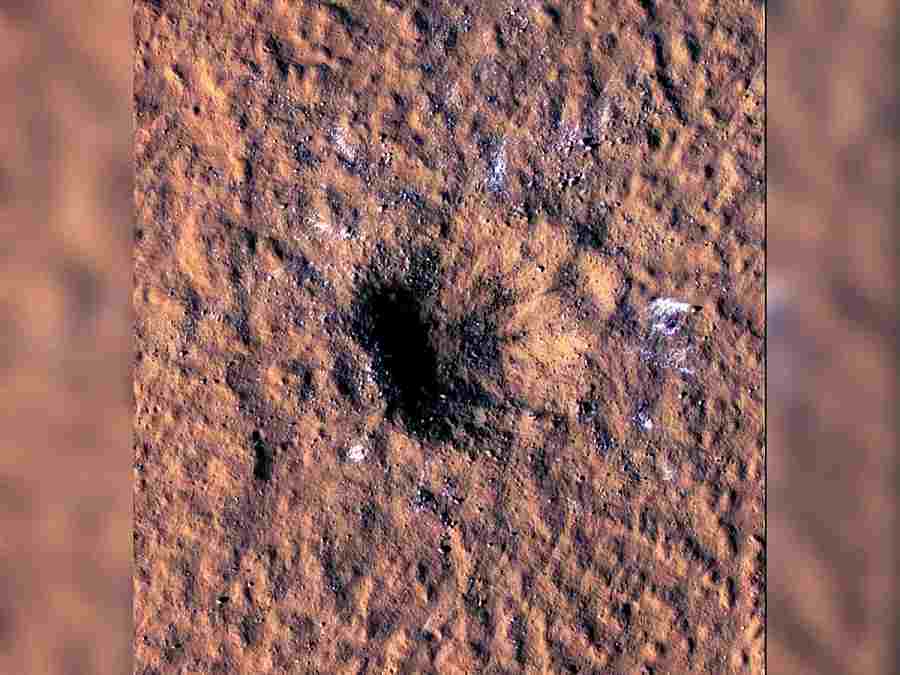![]() This image taken by the European Space Agency’s Mars Express orbiter shows an oblique view focusing on one of the fractures making up the Cerberus Fossae system. The fractures cut through hills and craters, indicating their relative youth.ESA/DLR/FU Berlin
This image taken by the European Space Agency’s Mars Express orbiter shows an oblique view focusing on one of the fractures making up the Cerberus Fossae system. The fractures cut through hills and craters, indicating their relative youth.ESA/DLR/FU Berlin
Tue 6 December 2022:
Mars, also known as the Red Planet, is the farthest from the Sun of the four rocky planets in the solar system, and the second closest to Earth.
It is a terrestrial planet with a thin atmosphere of carbon dioxide, and it has two small, irregularly shaped satellites, Phobos and Deimos. Currently, it is a dry, rocky, inhospitable, and cold planet.
Despite the fact that most of Mars’ volcanic and tectonic activity occurred during its first 1.5 billion years, a new study published by Nature and led by the University of Arizona has identified what is considered an active mantle plume 4,000 kilometers in diameter.

Third planet of the inner solar system with active volcanism
This would be found under Elysium Planitia, in the north of the planet, which pushes the crust upward and brings hot magma to the surface.
The study also highlights that Mars becomes the third known planet in the inner solar system with active volcanism, along with Earth and Venus.
The researchers behind the work are Adrien Broquet and Jeff Andrews-Hanna, scientists from the Lunar and Planetary Laboratory at the University of Arizona (United States).
They have extensively analyzed a diverse set of data taken by different spacecraft that have studied the Red Planet for decades, such as the Mars Global Surveyor and Mars Reconnaissance Orbiter, both from NASA.

Explication of the sysmic activity
This plume could explain the low but constant seismic activity, recently detected by the NASA InSight landing module that has been on Mars since 2018 and explores an area called Cerberus Fossae.
The most recent volcano on the planet was in this location 53,000 years ago and the authors determine that the center of the plume is also there.
“In another study by our group, we have found the most recent case of volcanism in the history of Mars: a small deposit of ash about 20 kilometers in diameter right in the center of the mantle plume. Its age is 50,000 years, which means yesterday in geological terms. All of this tells us that this region is active today,” Broquet argues on the matter.
Characteristics
These and other missions have allowed detailed topographical maps to be compiled, as well as studying the changes in the gravitational force exerted by the planet.
In fact, using geophysical models, they found evidence that the entire area is supported by a mantle plume of hot material between 95 and 285 kelvin, warmer than its surroundings.
This volcanism on Mars has similarities but also presents differences to that on Earth. The same process of mantle plumes and hot spots occurs in places like Hawaii or the Canary Islands.
As on Earth, there are tectonic plates that move like huge rafts on the mantle, the plumes cause eruptions that originate chains of islands. However, the mantle plume discovered on Mars is much larger than any that has existed on Earth.
NEWS AGENCIES
___________________________________________________________________________________________________________________________________
FOLLOW INDEPENDENT PRESS:
TWITTER (CLICK HERE)
https://twitter.com/IpIndependent
FACEBOOK (CLICK HERE)
https://web.facebook.com/ipindependent
Think your friends would be interested? Share this story!





